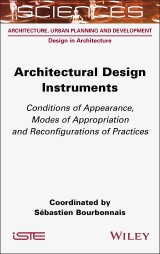Details
Architectural Design Instruments
Conditions of Appearance, Modes of Appropriation and Reconfigurations of Practices1. Aufl.
|
126,99 € |
|
| Verlag: | Wiley |
| Format: | |
| Veröffentl.: | 05.06.2024 |
| ISBN/EAN: | 9781394300815 |
| Sprache: | englisch |
| Anzahl Seiten: | 272 |
DRM-geschütztes eBook, Sie benötigen z.B. Adobe Digital Editions und eine Adobe ID zum Lesen.
Beschreibungen
<p>While it is undeniable that architectural practices have been transformed with the advent of digital technologies, they nevertheless continue to occupy an ambiguous or even problematic place within the design process.</p> <p>The underlying premise of this book on architectural design instruments is not to see them simply as means to an autonomous end, one that is pure and detached from any other technological aspect, but instead to see these instruments and their formative abilities as a different way in which architects can approach design. We maintain that it is through the very act of experimentation with these instruments that their various potentials are revealed and established. It is through such repeated experimentation, which is constantly being revised and consolidated, that practice is successfully and sustainably transformed.</p> <p>This view is less of a wish than it is an observation, and as such, it can be seen in the various practices that are analyzed in this book.</p>
<p>Introduction ix<br /><i>Sébastien BOURBONNAIS</i></p> <p><b>Chapter 1. Evolution of Architectural Software 1</b><br /><i>Sébastien BOURBONNAIS</i></p> <p>1.1. Introduction 1</p> <p>1.1.1. Difficulty of classification 3</p> <p>1.2. Human-computer interaction 6</p> <p>1.3. Technological imaginations and consciousness 10</p> <p>1.3.1. First meetings around the computer 11</p> <p>1.3.2. "Software", the constitution of a notion 14</p> <p>1.4. The pioneers 20</p> <p>1.4.1. The CAD (Computer-Aided Design) project 21</p> <p>1.4.2. Communicating with the machine, via drawing 24</p> <p>1.4.3. Representing the information 26</p> <p>1.4.4. The computer: an entity in its own right 29</p> <p>1.5. The complex problem of design 33</p> <p>1.5.1. Generating drawings 35</p> <p>1.5.2. Improving accurate algorithms 39</p> <p>1.5.3. Integrating building descriptions 43</p> <p>1.5.4. Increasing the objects of the design 45</p> <p>1.6. When industry takes over the software market 46</p> <p>1.6.1. Drawing programs 48</p> <p>1.6.2. Representation of spatiality 51</p> <p>1.7. User interface improvements 54</p> <p>1.7.1. The questioning of drawing 55</p> <p>1.7.2. Design with a 3D model 58</p> <p>1.7.3. Moving images 61</p> <p>1.8. Architects explore differently 64</p> <p>1.8.1. The craze for variation 66</p> <p>1.8.2. Tool-users and tool-makers 67</p> <p>1.8.3. The connection with the construction (CAD-CAM) 69</p> <p>1.9. A new bifurcation 71</p> <p>1.9.1. The end of unique software 72</p> <p>1.9.2. "More user-friendly" 74</p> <p>1.9.3. Restoring the simplicity of use 75</p> <p>1.9.4. Manipulating parameters 78</p> <p>1.9.5. BIM qualified practices. 79</p> <p>1.10. Conclusion 81</p> <p>1.11. References 82</p> <p><b>Chapter 2. Emergence of Pre-digital Algorithmic Design 91</b><br /><i>Denis DERYCKE</i></p> <p>2.1. Introduction 91</p> <p>2.2. Structuralism, generic process and specific object 92</p> <p>2.3. Architecture as an autonomous formal language 98</p> <p>2.4. The index sign, connection element of the virtual model to the current instance 104</p> <p>2.5. Axonometry, diagram and algorithmic process 106</p> <p>2.6. From the theoretical to the intuitive, from the East Coast to the West Coast 111</p> <p>2.7. Multiple instances: projects and conceptual artifacts 113</p> <p>2.8. Actual instances and virtual systems 120</p> <p>2.9. Conclusion 130</p> <p>2.10. References 132</p> <p><b>Chapter 3. Mapping the Affinities Between the Non-Standard and the Fold 135</b><br /><i>Florence PLIHON</i></p> <p>3.1. Introduction 135</p> <p>3.2. Contextual landscapes: the theoretical bias of architecture (1990-2000) 137</p> <p>3.2.1. Bernard Cache, Greg Lynn, UN Studio, "intercessors" of the Fold 137</p> <p>3.2.2. Terre Meuble and Folding, two key publications 140</p> <p>3.2.3. To constitute avant-garde 144</p> <p>3.3. Contextual landscapes: technological biases (1990-2000) 146</p> <p>3.3.1. The technological choices of Greg Lynn and Peter Eisenman 146</p> <p>3.3.2. Bernard Cache’s technological choices 149</p> <p>3.3.3. From pencil to computer mouse 151</p> <p>3.3.4. Architects who became digital specialists 153</p> <p>3.3.5. Standardization in question 154</p> <p>3.3.6. Fascination for the curve 156</p> <p>3.3.7. Back and forth between theory and practice 158</p> <p>3.4. Mapping of theoretical transfers 159</p> <p>3.4.1. Deleuze and architecture 159</p> <p>3.4.2. The Fold across the Atlantic 161</p> <p>3.4.3. An operational fold 162</p> <p>3.4.4. Deterritorializing the Fold: at what cost? 163</p> <p>3.5. Strategies: productive effects of the Deleuzian Fold on architecture 166</p> <p>3.5.1. Objective and modulation 166</p> <p>3.5.2. The blob, a theoretical and geometrical curiosity 168</p> <p>3.5.3. Towards a surface architecture? 171</p> <p>3.5.4. Morphogenesis and accidents 172</p> <p>3.6. Conclusion: towards a technological determinism? 174</p> <p>3.7. References 176</p> <p><b>Chapter 4. Hijacking the Tool: Towards a Transformation of the Architectural Representation 181</b><br /><i>Samuel BERNIER-LAVIGNE</i></p> <p>4.1. The detour 181</p> <p>4.1.1. From tool to instrument 182</p> <p>4.1.2. The question of representation in the digital age 184</p> <p>4.2. Hijacking the software 187</p> <p>4.3. Hijacking the machine 198</p> <p>4.4. Conclusion 207</p> <p>4.5. References 207</p> <p><b>Chapter 5. The Designer in the Informational Shift 211</b><br /><i>Aurélie DE BOISSIEU</i></p> <p>5.1. Introduction 211</p> <p>5.2. Leaving the notation regime: introducing emerging practices 212</p> <p>5.2.1. Data in the computational turn 212</p> <p>5.2.2. The information regime in practice with BIM 213</p> <p>5.2.3. Computational design. 216</p> <p>5.2.4. Towards a definition of "data-driven design" 219</p> <p>5.3. Evolution of possibilities and design postures in the informational shift 221</p> <p>5.3.1. Possibility space in relation to the data, some examples 221</p> <p>5.3.2. "Evidence-based" and "performance-based" postures 225</p> <p>5.3.3. Issues of integrated multi-objective performance 226</p> <p>5.4. Risk and data requirements 229</p> <p>5.4.1. Biases and limitations of the datasets 229</p> <p>5.4.2. The contributions and constraints of BIM to produce and maintain data collaboratively 230</p> <p>5.5. Data management opportunities for new approaches to projects 232</p> <p>5.5.1. BIM and the rise of data-supported collaboration 232</p> <p>5.5.2. The risks of data silos and the challenges of interoperability 234</p> <p>5.6. Conclusion 235</p> <p>5.7. References 236</p> <p>List of Authors 241</p> <p>Index 243</p>
<p><b>Sébastien Bourbonnais</b> is an assistant professor at the School of Architecture of Laval University, Canada. He has taught at several Écoles Nationales Supérieures d'Architecture (National Architectural Colleges) in France, is a research consultant at Asynth and a research associate at EVCAU.</p>



















